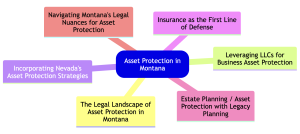
Understanding the Role of Elder Law Attorneys in Montana Healthcare Decisions
January 13, 2024
Veterans Benefits in Montana: How Elder Law Attorneys Can Assist
January 13, 2024Asset protection in Montana encompasses a range of strategies designed to safeguard assets against potential legal threats, ensuring that your wealth remains secure as you age. With the right approach, Montana residents can utilize elder law provisions to create a robust defense for their estate. This article delves into the legal tools and strategies available within Montana’s jurisdiction that can help protect your assets from unforeseen claims and liabilities.
Key Takeaways
- Asset Protection Importance: Understanding the significance of asset protection is crucial for Montana seniors.
- Legal Tools: In Montana, key strategies include utilizing trusts, family limited partnerships (FLPs), and LLCs.
- Professional Guidance: Seeking professional legal advice is essential for effective asset protection planning.
 The Legal Landscape of Asset Protection in Montana
The Legal Landscape of Asset Protection in Montana
Montana’s legal framework offers various avenues for asset protection, tailored to the unique needs of its senior residents. Navigating this landscape requires a clear understanding of the tools and laws at your disposal.
Proactive Measures Against Elder Financial Abuse
Elder financial abuse is a growing concern, and Montana has enacted laws to protect its senior population. These measures include stringent penalties for abusers and comprehensive legal frameworks to recover assets.
- Legal Recourse: Montana provides legal recourse for victims, including restitution and possibly criminal charges against perpetrators.
- Prevention Strategies: Education on common scams and financial planning advice are crucial to prevention.
Family Limited Partnerships: A Montana Elder Law Perspective
Family Limited Partnerships (FLPs) serve as a vehicle for managing family-owned business interests and can be an effective tool for asset protection.
- Asset Management: FLPs allow for centralized management of assets, making it easier to control and protect wealth.
- Benefits: They offer tax benefits and can protect assets from personal creditors of the partners.
Trusts as a Fortress for Your Assets
Trusts are a cornerstone of asset protection in Montana, with options ranging from revocable to irrevocable and spendthrift trusts.
- Revocable vs Irrevocable Trusts: Understanding the differences between these trusts is vital, as they offer varying levels of protection and flexibility.
- Spendthrift Trusts: These trusts can protect beneficiaries from their creditors and ensure that the trust assets are used as intended by the grantor.
Continuing from where we left off:
Leveraging LLCs for Business Asset Protection
In Montana, Limited Liability Companies (LLCs) are a popular choice for business owners seeking to protect their assets. An LLC can shield personal assets from business liabilities, separating personal wealth from the obligations of the business.
- Separation of Assets: LLCs create a legal barrier between business debts and personal property.
- Operational Flexibility: They offer operational flexibility and fewer formalities compared to corporations.
Incorporating Nevada’s Asset Protection Strategies
Montana residents can benefit from Nevada’s favorable asset protection laws thanks to the possibility of creating cross-state legal structures.
- Nevada Trusts: Nevada-based trusts can offer more robust asset protection features due to Nevada’s progressive trust laws.
- Cross-State Synergy: Combining Montana and Nevada laws can maximize asset protection for Montana residents.
Insurance as the First Line of Defense
Insurance policies serve as a critical first layer of defense in an asset protection strategy, offering immediate financial relief in the face of claims or lawsuits.
- Coverage Selection: Choosing the right type and amount of insurance coverage is crucial for effective asset protection.
- Role of Insurance: Insurance can mitigate the risk of asset depletion due to legal challenges or creditor claims.
Advanced Asset Protection Techniques
Montana offers advanced techniques, such as equity stripping and captive insurance companies, to further protect the wealth of those with significant assets.
- Equity Stripping: This involves reducing the equity in assets, making them less attractive to creditors.
- Captive Insurance: Creating a private insurance company can provide customized coverage and potentially offer tax benefits.
Asset Protection Strategies Comparison Table
| Strategy | Description | Benefits | Considerations |
| LLCs | Business entity that separates personal and business assets. | Liability protection, operational flexibility. | Requires proper formation and maintenance. |
| Nevada Trusts | Trusts established under Nevada law. | Enhanced protection features, potential tax advantages. | May involve cross-state legal complexity. |
| Insurance | Policies that provide financial coverage. | Immediate relief from claims, preserves assets. | Must be tailored to specific asset protection needs. |
| Equity Stripping | Reducing the equity in assets. | Makes assets less attractive to creditors. | Can be complex, requires careful planning. |
| Captive Insurance | Private insurance company for one’s own business. | Customized coverage, potential tax benefits. | Regulatory compliance, initial setup cost. |
Asset Protection Myths Debunked: Montana Edition
Misinformation can lead to costly mistakes in asset protection planning. Dispelling common myths is crucial to ensuring that Montana residents are well-informed.
- Myth vs. Reality: Clarify misconceptions about the ease and legality of hiding assets.
- Expert Insights: Provide professional advice to navigate complex asset protection laws effectively.
Estate Planning Synergy: Combining Asset Protection with Legacy Planning
Asset protection should work in concert with estate planning to ensure a comprehensive approach to wealth management.
- Holistic Approach: Integrate asset protection into the broader estate planning context for a unified strategy.
- Legacy Goals: Align asset protection measures with legacy and succession planning to ensure long-term goals are met.
Navigating Montana’s Legal Nuances for Asset Protection
In Montana, asset protection strategies must be tailored to align with state-specific laws that govern estate planning and financial transactions.
For instance, Montana’s Uniform Trust Code provides a framework for the creation and administration of trusts, which are pivotal in asset protection. Trusts in Montana can be designed to offer spendthrift provisions, which prevent creditors from claiming a beneficiary’s future inheritance.
Additionally, Montana allows for the creation of Domestic Asset Protection Trusts (DAPTs), which are self-settled trusts that let the trust maker be a discretionary beneficiary while still offering protection from creditors.
Montana also has unique provisions regarding LLCs.
The state allows for the formation of Series LLCs, which can be beneficial for segregating assets within different series or cells, each insulated from the liabilities of the others. This can be particularly advantageous for real estate investors who wish to protect individual properties from cross-liability. (1)
The Role of Federal Taxation in Asset Protection
Federal tax considerations are integral to designing an asset protection plan. The structure of your asset protection vehicles can have significant tax implications.
For example, transferring assets into an irrevocable trust may remove those assets from your taxable estate, potentially reducing estate taxes upon death. However, this transfer could trigger a taxable event if improperly structured, leading to immediate capital gains taxes.
In Montana, utilizing DAPTs can offer tax advantages. Since the trust maker can be a discretionary beneficiary, they may have access to the trust’s assets without directly owning them, which can be beneficial for tax purposes. However, it’s important to note that the IRS scrutinizes such arrangements closely, and professional guidance is crucial to ensure compliance with tax laws.
Strategic asset protection planning must also consider the potential for future changes in tax legislation. For instance, the exemption amounts for federal estate taxes are subject to legislative changes, which could affect the tax efficiency of your asset protection plan. Keeping abreast of these changes and adapting your strategy accordingly is essential for maintaining both protection and tax efficiency.
Montana residents can create a robust asset protection strategy that resists potential creditors and tax obligations by understanding and applying the state’s specific legal and tax provisions.
Conclusion
Asset protection in Montana requires a strategic approach encompassing various legal tools and techniques. By understanding the intricacies of elder law and utilizing the right strategies, Montana residents can effectively secure their wealth against potential threats. It’s imperative to consult with legal experts specializing in Montana’s asset protection laws to tailor a plan that meets individual needs and ensures peace of mind for the future.
Final Takeaway
- Asset protection in Montana is a nuanced and essential aspect of financial planning, particularly for older adults.
- Combining asset protection with comprehensive estate planning ensures your legacy is preserved according to your wishes.
Reference
(1) For further reading on asset protection strategies and their legal implications, consider the comprehensive guide provided by The American Bar Association.

